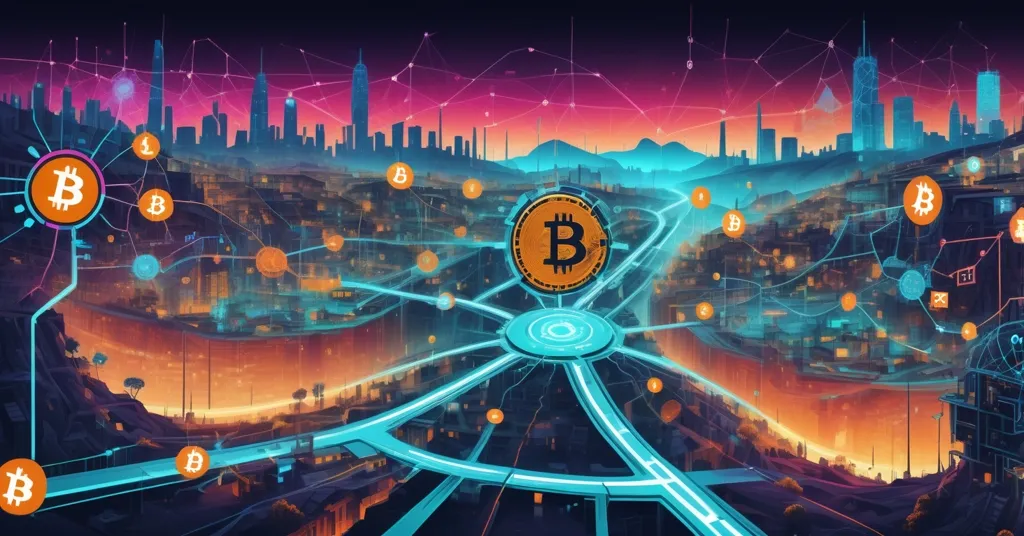Microsoft’s AI Divide Warning: Bitcoin and Blockchain Must Prioritize Inclusion

Microsoft’s AI Divide Alarm: A Wake-Up Call for Bitcoin and Blockchain Inclusion
Artificial Intelligence (AI) is spreading across the globe faster than electricity, computers, or the internet ever did, with over 1.2 billion users already on board. But Microsoft’s latest AI Diffusion Report throws cold water on the hype, exposing a dangerous divide that leaves billions behind due to language barriers, shaky infrastructure, and unequal access. For us in the crypto space, this isn’t just a tech story—it’s a stark warning about the pitfalls of disruption without equity, and a mirror to Bitcoin and blockchain’s own challenges.
- Record-Breaking Adoption: AI usage surpasses historic tech revolutions with 1.2 billion users worldwide.
- Growing Divide: Billions are excluded by language, internet, and electricity gaps, much like crypto’s accessibility hurdles.
- Lessons for Crypto: Microsoft’s call for inclusive action echoes Bitcoin’s mission to empower the unbanked.
AI’s Unmatched Rise and Stark Disparities
The speed of AI adoption is nothing short of jaw-dropping. Over 1.2 billion people are already using AI tools, outpacing the rollout of foundational technologies that shaped the modern world. Nations like the UAE (59.4% adoption), Singapore (58.6%), and Norway (51.9%) lead the charge, thanks to near-universal internet, reliable power, and a population that’s digitally savvy. These countries are cashing in on AI’s promise—think smarter businesses, streamlined services, and boosted productivity. But flip the map to Sub-Saharan Africa, South Asia, or Latin America, and the picture darkens. Fewer than 10% of people in these regions use AI, crippled by spotty internet, power outages, and a lack of devices or education. Microsoft pulls no punches, warning that
“Unless digital infrastructure and education catch up, this gap will define who benefits from AI for decades to come.”
Sound familiar? Bitcoin and blockchain face the same damn problem—disruption is meaningless if half the world can’t plug in.
The Infrastructure Roadblock: A Shared Struggle
Let’s talk hardware. AI’s engine is built on data centers—think of them as giant supercomputers crunching numbers nonstop to power chatbots, predictive tools, and more. The US dominates with 53.7 gigawatts (GW) of data center capacity, followed by China at 31.9 GW, Germany at 8.5 GW, and the UK at 7.4 GW. These stats aren’t just geek trivia; they show who’s wired for the future. Meanwhile, over 700 million people globally lack consistent electricity, a fatal barrier to AI access. Picture a farmer in rural Africa unable to use AI crop prediction tools because there’s no power—or a Bitcoin wallet for that matter. Same issue, different tech. Bitcoin mining rigs and network nodes also demand stable electricity and internet, often out of reach in developing regions. Small-scale miners in areas with unreliable grids struggle, though innovations like solar-powered nodes offer hope. If we’re serious about decentralization, crypto needs to solve this infrastructure puzzle just as urgently as AI does.
Language as a Barrier: Exclusion by Design
Then there’s the silent killer: language. Most AI models are trained on English and a few other dominant languages, ignoring billions who speak the world’s 7,000 other tongues, including what’s known as low-resource languages—those with little online data or digital tools to support AI training, like Hausa or Bengali. It’s not just a glitch; it’s exclusion baked into the code. Imagine firing up a cutting-edge AI app only to find it doesn’t understand your native speech. Frustrating? Try infuriating. Microsoft calls this out as a massive hurdle, stressing that
“The challenge is not only scale, but also coordination. Fragmented efforts and a lack of unified strategy continue to slow momentum and dilute impact.”
This isn’t just AI’s problem. Crypto’s English-heavy resources, dense jargon, and lack of localized wallets or tutorials alienate potential users too. If Bitcoin is to be the people’s money, we need interfaces and education in every language, just as AI needs diverse models. Otherwise, we’re just building walled gardens with better branding.
Privacy Clash: AI’s Hunger vs. Bitcoin’s Ethos
Here’s a darker angle—privacy. AI thrives on data, gobbling up personal info to train models, often with little regard for consent or anonymity. That’s a direct clash with Bitcoin’s core promise of privacy and self-sovereignty. Imagine AI integrated into blockchain systems for scalability or smart contracts, but at the cost of surveillance creep. It’s not science fiction; it’s a real risk. Crypto projects must guard against this with tools like zero-knowledge proofs—tech that verifies transactions without exposing details—or privacy-focused altcoins like Monero. We champion effective accelerationism, pushing tech forward, but not if it means trading one Big Brother for another. AI’s data addiction is a cautionary tale for decentralized finance (DeFi); let’s not screw this up by being careless.
Africa’s Untapped Potential: A Dual Opportunity
Amid the gloom, Microsoft spots a goldmine in Africa, projecting 230 million AI-powered jobs if the right moves are made. That’s not pocket change—it’s a tectonic shift for a continent often sidelined in tech narratives. But it’s no solo gig; it demands a unified push from governments, industry, education, and civil society to build what Microsoft describes as a
“coordinated, inclusive skilling ecosystem, where government, education, industry, and civil society work together to shape the AI economy.”
Crypto can ride this wave. Bitcoin adoption is already gaining ground in places like Nigeria, where peer-to-peer trading bypasses broken financial systems, or Kenya, where blockchain experiments tie into mobile money platforms like M-Pesa. Aligning crypto initiatives with AI skilling programs could turbocharge financial inclusion alongside job creation. But let’s play devil’s advocate: 230 million jobs sound sexy, but without cracking down on corruption or ensuring fair rollout, both AI and crypto could just fatten a new local elite. We’ve seen that movie before, and it doesn’t end well.
Historical Echoes and Crypto’s Edge
Tech divides aren’t new. Mobile phones started as toys for the rich before becoming near-universal, thanks to dropping costs and smart policies. AI might follow that arc, but its blistering pace leaves less room for delay. Crypto, though, has a grassroots edge—Bitcoin wasn’t born in a corporate lab but from a pseudonymous rebel’s code. That DIY spirit could outpace AI’s top-down rollout if we prioritize accessibility over hype. Turning a blind eye to these gaps isn’t just dumb—it’s a bloody disaster waiting to happen for global equity, whether we’re talking AI or blockchain. As Bitcoiners, we’ve got to ask: are we building a future where decentralization means inclusion, or just swapping one set of gatekeepers for another?
Convergence Potential: AI and Blockchain Synergy
Looking ahead, AI and blockchain could be powerful allies. AI might optimize blockchain scalability—think faster transaction processing or smarter consensus mechanisms. Smart contracts on platforms like Ethereum could enforce accountability in AI systems, curbing data misuse. But risks loom large. Centralized AI could undermine decentralized ideals if not paired with privacy-first design. Altcoins and protocols beyond Bitcoin have a role here, filling niches with specialized tools—think privacy coins or DeFi platforms that AI can’t touch. We’re all for accelerating progress, but let’s keep our eyes wide open. Disruption without equity is just privilege with extra steps.
Key Insights and Questions on AI and Crypto Divides
- How does AI’s adoption speed compare to past tech, and what’s the crypto takeaway?
AI’s 1.2 billion users outstrip electricity or internet growth, pushing crypto to match that pace with accessible, decentralized tools like Bitcoin for mass adoption. - Why are billions excluded from AI, and how does this reflect crypto barriers?
Language gaps, no electricity, and poor internet lock out billions from AI, mirroring crypto’s struggles with tech literacy and infrastructure in underserved areas. - Which regions lead in AI, and what can blockchain hubs learn?
UAE, Singapore, and Norway excel with strong infrastructure and literacy, showing blockchain must prioritize access and education to build inclusive adoption zones. - What’s Africa’s potential for AI and crypto synergy?
Africa could gain 230 million AI jobs with coordinated efforts, and crypto like Bitcoin can drive financial inclusion by aligning with these infrastructure pushes. - What risks emerge if these divides persist in AI and blockchain?
Unchecked gaps could lock in inequality for generations, risking crypto’s promise if decentralization doesn’t truly reach the masses beyond elite circles. - How might AI and blockchain intersect, for better or worse?
AI could boost blockchain efficiency, but data hunger threatens privacy; crypto must leverage privacy tools and altcoin niches to balance acceleration with ideals.
Microsoft’s report is a blaring siren for tech of all stripes. The AI divide isn’t just a problem—it’s a crisis demanding collective grit, not empty promises. For us in the Bitcoin and blockchain space, it’s a gut check. We’re hell-bent on disrupting broken systems, championing freedom, and accelerating progress, but not if it leaves half the world in the dust. Bitcoin, as the ultimate decentralized currency, must lead the charge where AI stumbles, while altcoins carve out vital niches. If we don’t learn from AI’s missteps, we’re not revolutionaries—we’re just peddling a shinier cage.



